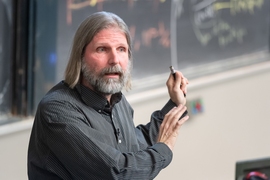As her topic for the 2021 Mildred S. Dresselhaus Lecture, Stanford University professor Jelena Vučković posed a question: Are computers better than humans in designing photonics?
Throughout her talk, presented on Nov. 15 in a hybrid format to more than 500 attendees, the Jensen Huang Professor in Global Leadership at Stanford’s School of Engineering offered multiple examples arguing that, yes, computer software can help identify better solutions than traditional methods, leading to smaller, more efficient devices, as well as entirely new functionalities.
Photonics, the science of guiding and manipulating light, is used in many applications such as optical interconnects, optical computing platforms for AI or quantum computing, augmented reality glasses, biosensors, medical imaging systems, and sensors in autonomous vehicles.
For all these applications, Vučković said, many optical components must be integrated on a chip that can fit into the footprint of your glasses or mobile device. Unfortunately, the problems with high-density photonic integration are several. Traditional photonic components are large, sensitive to fabrication errors and environmental factors such as variations in temperature, and are designed by manual tuning with few parameters. So, Vučković and her team asked, “How can we design better photonics?”
Her answer: photonics inverse design. In this process, scientists rely on sophisticated computational tools and modern computing platforms to discover optimal photonic solutions or device designs for a particular function. In this inverse process, the researcher first considers how he or she would like the photonic block to operate, then uses computer software to search the whole parameter space of possible solutions for the one that is optimal, within fabrication restraints.
From guiding light around corners to splitting colors of light in a compact footprint, Vučković presented several examples to prove this process works — using computer software to conduct physics-guided searches of numerous possibilities produces non-traditional solutions that increase efficiency and/or decrease the footprint of photonic devices.
Enabling new functionalities – high-energy physics
State-of-the-art particle accelerators, which use microwaves or radio frequency waves to propel charged particles, can be the size of a full city block; Stanford’s SLAC National Accelerator Lab, for example, is two miles long. Lower-energy accelerators, such as those used in medical radiation facilities, are not as large, but still take up an entire room, are expensive, and not very accessible. “If we could use a different spectrum of electromagnetic waves with shorter wavelengths to do the same function of accelerating particles,” said Vučković, “we should, in principle, be able to shrink the size of an accelerator.” The solution is not as simple as reducing the size of all the parts, as the electromagnetic building blocks won’t work for optical waves. Instead, Vučković and her team used the inverse design process to create new building blocks, and built a single-stage on-chip integrated laser-driver particle accelerator that is only 30 micrometers in length.

Applying inverse designed photonics to practical environments
Autonomous vehicles have a large lidar system on the roof housing mechanics that enable rotation of a beam to scan the environment. Vučković considers how this could be improved. “Can you make this system inside the footprint of a single chip, which would be just like another sensor in your car, and can it be inexpensive?” Through inverse design, her research group found optimal photonic structures to enable steering the beam with inexpensive lasers that are cheaper, and achieve 5 degrees of additional beam steering, than state-of-the-art systems.
Next up: scaling superconducting quantum processors onto a single diamond or silicon carbide chip. In this example, Vučković harkened back to the 2020 Dresselhaus Lecture delivered by Harvard Professor Evelyn Hu on leveraging defects at the nanoscale. By relying on impurities in these materials at low concentrations, naturally trapped atoms can be very useful for quantum applications. Vučković’s group is working on material developments and fabrication techniques that allow them to put these trapped atoms in desired positions with minimal defects.
“For many applications, letting computer software search for an optimal solution leads to better solutions than what you would design, or guess, based on your intuitions. And this process is material-agnostic, fully compatible with commercial foundries, and enables new functionalities,” said Vučković. “Even if you try to make something a little bit better than traditional solutions — smaller in a footprint or higher in efficiency — we can come up with multiple solutions that are equally good or better than what we knew before. We are relearning photonics and electromagnetics in this process.”
Honoring Mildred S. Dresselhaus and Gene Dresselhaus
Vučković was the third speaker to deliver the Dresselhaus Lecture, established in 2019 to honor the late MIT physics and electrical engineering professor Mildred Dresselhaus. This year, the lecture was also dedicated to Gene Dresselhaus, renowned physicist and Millie’s husband, who passed away in late September 2021.
Jing Kong, professor of electrical engineering and computer science at MIT, opened the lecture by reflecting on the Dresselhaus’s scientific achievements. Kong highlighted the American Physical Society Oliver E Buckley Condensed Matter Physics Prize — considered the most prestigious award granted within the field of condensed-matter physics — that was awarded to both Millie (2008) and Gene (2022). “Although they worked together on many important topics,” said Kong, “It’s remarkable that they received this award for separate research works. It is humbling for us to walk in their footsteps.”













